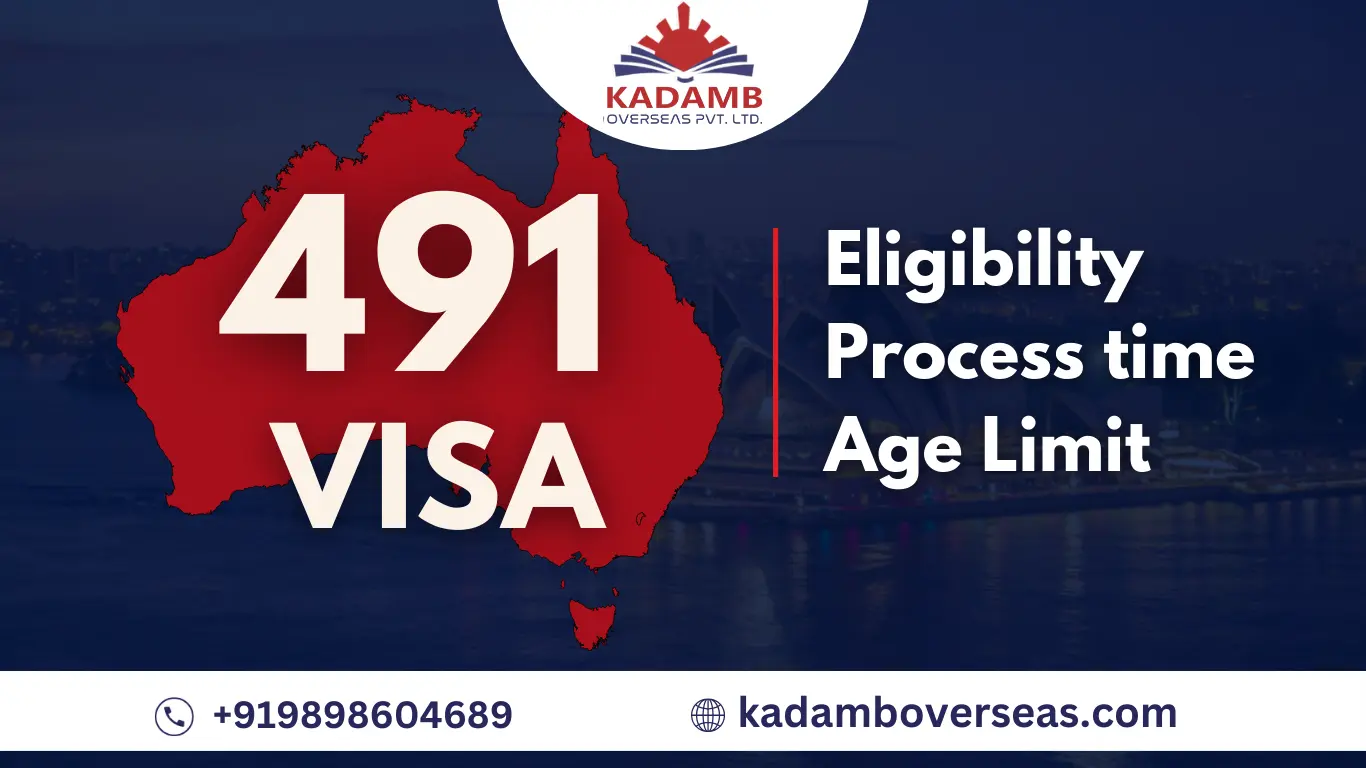The 491 visa is a popular pathway for skilled workers and their families to migrate to Australia. This visa was introduced in November 2019 as a replacement for the 489 visa. The 491 visa is a points-based visa that requires applicants to meet certain criteria to be eligible.
To be eligible for the 491 visa, applicants must have a nominated occupation on the relevant skilled occupation list. They must also meet the minimum points requirement, which is currently 65 points. The 491 visa also requires applicants to be under the age of 45, have competent English language skills, and meet health and character requirements.
Once granted, the 491 visa comes with certain conditions that must be met. These conditions include living and working in a designated regional area of Australia for at least three years. After this period, visa holders may be eligible to apply for permanent residency through the Skilled Regional visa (subclass 191). Understanding the requirements, processing time, and benefits of the 491 visa is crucial for those considering this pathway to migrate to Australia.
Overview of the 491 Visa Requirements, Processing Time, Points
The 491 visa is a skilled regional visa that allows skilled workers to live and work in regional areas of Australia for up to five years. This visa is designed to address skill shortages in regional areas and to encourage migration to those areas.
491 Visa Eligibility Criteria
To be eligible for the 491 visa, applicants must meet the following criteria:
- Have a relevant occupation on the Medium and Long-term Strategic Skills List (MLTSSL) or the Regional Occupation List (ROL)
- Have a positive skills assessment for their nominated occupation
- Be under 45 years of age
- Have competent English language proficiency
- Be nominated by a state or territory government agency or sponsored by an eligible family member residing in a designated regional area
- Meet the health and character requirements
491 Visa Application Process
The application process for the 491 visa involves the following steps:
- Check if you meet the eligibility criteria
- Submit an Expression of Interest (EOI) through SkillSelect
- Wait for a state or territory government agency or eligible family member to nominate you
- Once nominated, you will receive an invitation to apply for the visa
- Lodge your visa application within 60 days of receiving the invitation
- Wait for the Department of Home Affairs to process your application
The processing time for the 491 visa varies depending on a range of factors, including the completeness of your application and the demand for the visa. It is recommended that you allow at least six months for processing.
Overall, the 491 visa offers a range of benefits, including the opportunity to live and work in regional areas of Australia, access to Medicare, and the ability to apply for permanent residency after three years.
491 Visa Requirements
The 491 visa is a skilled work regional (provisional) visa that allows skilled workers to live and work in a designated regional area of Australia for up to five years. To be eligible for a 491 visa, applicants must meet certain requirements.
Primary Applicant Requirements
The primary applicant must meet the following requirements:
- Age: The primary applicant must be under 45 years of age at the time of application.
- Occupation: The primary applicant must have a nominated occupation on the relevant skilled occupation list.
- Skills Assessment: The primary applicant must have a positive skills assessment for their nominated occupation.
- English Language: The primary applicant must have competent English language skills.
- Health and Character: The primary applicant must meet the health and character requirements set by the Australian government.
- Points Test: The primary applicant must score at least 65 points on the points test.
Dependent Applicant Requirements
Dependent applicants must meet the following requirements:
- Relationship: Dependent applicants must be the spouse or dependent child of the primary applicant.
- Age: Dependent applicants must be under 23 years of age or financially dependent on the primary applicant.
- Health and Character: Dependent applicants must meet the health and character requirements set by the Australian government.
It is important to note that meeting the above requirements does not guarantee the grant of a 491 visa. The Department of Home Affairs may refuse an application if it is not satisfied that the applicant meets the relevant criteria.
491 Visa Points Calculator
Points Breakdown
The 491 visa is a points-based visa, which means that applicants must meet certain eligibility criteria to be granted a visa. The points system is designed to assess an applicant’s ability to contribute to the Australian economy and society. The minimum points requirement for a 491 visa is 65 points.
The points breakdown for a 491 visa is as follows:
- Age: Applicants can score a maximum of 25 points for age. The maximum points are awarded to applicants who are between 25 and 32 years old. Applicants who are over 45 years old do not receive any points.
- English language proficiency: Applicants can score a maximum of 20 points for English language proficiency. The points are awarded based on the results of an approved English language test.
- Skilled employment: Applicants can score a maximum of 20 points for skilled employment in Australia. The points are awarded based on the number of years of skilled employment in Australia.
- Education: Applicants can score a maximum of 20 points for their educational qualifications. The points are awarded based on the level of education and the field of study.
- Regional study: Applicants can score a maximum of 5 points for studying in a regional area of Australia.
- Partner skills: Applicants can score a maximum of 10 points if their partner meets the requirements for skilled employment or has competent English language proficiency.
Strategies to Increase Points
There are several strategies that applicants can use to increase their points score and improve their chances of being granted a 491 visa. These include:
- Improving English language proficiency: Applicants can improve their English language proficiency by taking an approved English language test and achieving a higher score. This can increase their points score by up to 20 points.
- Studying in a regional area: Applicants can study in a regional area of Australia to qualify for the regional study points. This can increase their points score by up to 5 points.
- Applying for state nomination: Applicants can apply for state nomination to increase their chances of being granted a 491 visa. State nomination can provide additional points and may also make an applicant eligible for a wider range of occupations.
- Applying for skilled employment: Applicants can apply for skilled employment in Australia to increase their points score. Skilled employment can provide up to 20 points, depending on the number of years of employment.
- Partner skills: Applicants can increase their points score by up to 10 points if their partner meets the requirements for skilled employment or has competent English language proficiency.
491 Visa Processing Time
Expected Time Frame
The processing time for a 491 visa application can vary based on several factors. Typically, the Department of Home Affairs aims to process 75% of complete 491 visa applications within 9 months and 90% within 12 months. However, it is important to note that this is an estimated timeframe and processing times can be longer or shorter depending on individual circumstances.
It is recommended that applicants submit a complete and accurate application to avoid delays in processing. Incomplete applications or applications with errors or omissions may result in additional processing time.
Factors Affecting Processing
Several factors can affect the processing time of a 491 visa application. These include:
- Completeness and accuracy of the application
- Number of applications received by the Department of Home Affairs
- Complexity of the case
- Verification of supporting documents
- Security and health checks
It is important for applicants to be aware of these factors and to provide all necessary information and documentation to ensure a smooth and timely processing of their application.
Overall, the processing time for a 491 visa application can vary, but by submitting a complete and accurate application and being aware of the factors that can affect processing, applicants can increase their chances of a timely and successful outcome.
Conditions After Visa Grant
Residence Requirements
After being granted a 491 visa, the visa holder must live and work in a designated regional area for at least three years. The regional area can be anywhere in Australia except for Sydney, Melbourne, and Brisbane. The visa holder must also notify the Department of Home Affairs of any changes to their residential address within 14 days of the change.
Employment Obligations
The visa holder must work in a designated regional area for at least three years. This can be full-time or part-time work, and the work must be in an eligible occupation. The visa holder must also notify the Department of Home Affairs of any changes to their employment within 14 days of the change.
It is important to note that failure to comply with these conditions may result in the visa being cancelled and the visa holder being required to leave Australia. It is recommended that visa holders keep detailed records of their residential address and employment to ensure compliance with these requirements.
Overall, the 491 visa provides a pathway to permanent residency for skilled workers who are willing to live and work in regional areas of Australia. By fulfilling the residence and employment obligations, visa holders can successfully transition to permanent residency and enjoy the benefits that come with it.
Also Read: Type of Visas and PTE Score for Australian PR
Pathway to Permanent Residency
Eligibility for Permanent Residency
The 491 visa is a pathway to permanent residency in Australia. To be eligible for permanent residency, the visa holder must meet certain requirements. These requirements include:
- The visa holder must have lived and worked in a designated regional area for at least three years while holding a 491 visa.
- The visa holder must have earned a minimum taxable income for three years while holding a 491 visa.
- The visa holder must meet the health and character requirements set by the Australian Government.
If the visa holder meets these requirements, they can apply for permanent residency through the Subclass 191 visa.
Application Steps for PR
To apply for permanent residency through the Subclass 191 visa, the visa holder must follow these steps:
- Meet the eligibility requirements for permanent residency.
- Submit an Expression of Interest (EOI) through the SkillSelect system.
- Receive an invitation to apply for permanent residency.
- Lodge a complete application for permanent residency within 60 days of receiving the invitation.
- Provide all necessary documents and pay the application fee.
- Wait for the Department of Home Affairs to process the application.
It is important to note that the processing time for permanent residency applications can vary depending on individual circumstances. However, holding a 491 visa can increase the chances of being granted permanent residency in Australia.
Overall, the 491 visa is a viable pathway to permanent residency for skilled workers who are willing to live and work in designated regional areas of Australia.
Occupation List for 491 Visa
Skilled Occupations
To be eligible for a 491 visa, applicants must have a skilled occupation on the relevant list of eligible skilled occupations. This list is updated regularly and includes a wide range of occupations across various industries, such as healthcare, engineering, information technology, and trades. Applicants must have their skills and qualifications assessed by a relevant assessing authority to ensure they meet the requirements for their nominated occupation.
State-Specific Occupations
In addition to the skilled occupations list, each state and territory in Australia has its own list of state-specific occupations that are in demand and eligible for sponsorship under the 491 visa. These lists are designed to address specific skills shortages in each state and territory and may include occupations that are not on the national list.
Applicants must check the relevant state or territory list to see if their occupation is eligible for sponsorship in that area. They must also meet any additional requirements set by the state or territory, such as minimum work experience or English language proficiency.
Overall, the occupation lists for the 491 visa provide a clear and comprehensive guide for applicants to determine their eligibility for the visa. By ensuring they have a skilled occupation on the list and meeting any additional requirements, applicants can increase their chances of being granted the visa and starting a new life in Australia.
Benefits of 491 Visa
The 491 visa is a popular option for individuals who wish to migrate to Australia. This visa not only allows them to live and work in Australia but also provides them with several benefits. Here are some of the benefits of the 491 visa:
Work and Study Rights
The 491 visa allows individuals to work and study in Australia. They can work for any employer in any occupation, provided it is in a regional area of Australia. This visa also allows them to study full-time in any course of their choice.
Medicare Access
The 491 visa holders are eligible for Medicare, which is Australia’s public health care system. This means that they can access medical services and treatment at a reduced cost.
Travel Privileges
The 491 visa holders can travel in and out of Australia as many times as they want while the visa is valid. They can also apply for Australian citizenship after meeting the residency requirements.
Overall, the 491 visa provides individuals with an opportunity to live and work in Australia and enjoy the benefits of the Australian lifestyle.
State and Territory Nomination
Nomination Process
To be eligible for a 491 visa, applicants must first receive a nomination from an Australian state or territory government. The nomination process involves submitting an expression of interest (EOI) through the SkillSelect system and then being invited to apply for nomination by the relevant state or territory government.
Once an invitation has been received, applicants must submit a detailed application outlining their qualifications, work experience, and other relevant factors that demonstrate their suitability for the visa. The state or territory government will then assess the application and decide whether or not to nominate the applicant for a 491 visa.
State-Specific Requirements
Each state and territory has its own specific requirements for 491 visa nomination. These requirements may include:
- Meeting a minimum score on the state or territory’s points-based assessment system
- Having a job offer in a specified occupation that is in demand in the state or territory
- Meeting residency or other eligibility requirements, such as having lived or studied in the state or territory for a certain amount of time
It is important to carefully review the requirements of the state or territory where you wish to apply for nomination, as they may vary significantly from one location to another.
In addition to meeting the state or territory’s nomination requirements, applicants must also meet the general requirements for a 491 visa, including having a relevant occupation on the skilled occupation list and meeting the minimum points threshold.
Financial Considerations
491 Visa Application Charges
The 491 visa application fee is AUD 4,045 for the primary applicant. Additional fees may apply for family members included in the application. It is important to note that the application fee is non-refundable, even if the visa is not granted.
In addition to the application fee, applicants may also incur other charges such as health assessments, police certificates, and English language tests. These costs can vary depending on individual circumstances and should be factored into financial planning.
Settlement Funds
Applicants for the 491 visa must demonstrate that they have sufficient funds to support themselves and their dependents for at least three months after their arrival in Australia. The amount required will depend on family size and can be calculated using the Department of Home Affairs’ guidelines.
It is important to note that settlement funds must be held in a financial institution and cannot be borrowed. Applicants must provide evidence of their funds as part of their visa application.
Overall, financial planning is an important aspect of the 491 visa application process. Applicants should carefully consider all costs associated with the visa and ensure they have sufficient funds to support themselves and their dependents upon arrival in Australia.
Supporting Documentation
491 Required Documents
To apply for a 491 visa, applicants must provide a range of documentation to support their application. The following documents are required:
- A valid passport
- Evidence of English language proficiency
- Skills assessment from a relevant assessing authority
- Proof of work experience
- Education qualifications
- Evidence of health insurance
- Police clearance certificates from all countries where the applicant has lived for 12 months or more in the last 10 years
- Evidence of financial capacity
Applicants should ensure that all documents are certified copies and translated into English if necessary. Failure to provide all required documents may result in delays or rejection of the application.
Document Verification
The Department of Home Affairs may verify the authenticity of the documents provided by the applicant. This may include contacting the relevant authorities or institutions to confirm the validity of the documents.
It is important that applicants provide accurate and genuine documents to avoid any issues during the application process. Providing false or misleading information may result in the application being refused and may have serious consequences for future visa applications.
Therefore, applicants are advised to ensure that all documents provided are authentic and meet the requirements set out by the Department of Home Affairs.





